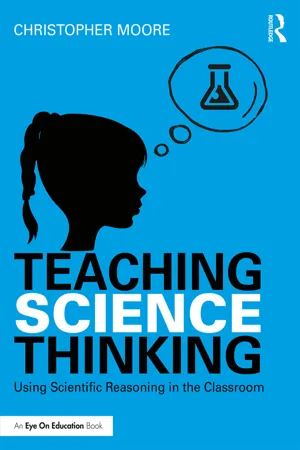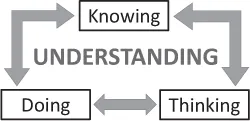![]()
Part I
Teaching and Learning Science Thinking
![]()
1
What Is Science Thinking?
“Is scientific thinking of any relevance outside of science? I answer this question with an emphatic yes and portray scientific thinking as a human activity engaged in by most people, rather than a rarefied few.”
—Deanna Kuhn (Kuhn, 2004, p. 2)
If we want to teach students how to think like scientists, then we first have to define science thinking. Sociologists have spent decades following natural and physical scientists around and observing their behavior in an effort to answer two important questions:
- What do scientists do? and
- How do scientists think?
According to these sociologists, “science thinking” can be fundamentally defined as the way expert scientists think about problems in their field – “science thinking” is the thinking done by scientists (Latour, 1987). There are a few other ways to think about science thinking. However, if we can teach students to think and act like practicing scientists, then in the process they will learn the community accepted practices for discovering new truths about the physical world around them, and the important critical thinking abilities necessary to know that what they are doing is scientific.
It all seems simple enough, but it still presents us with the question: how exactly does a scientist think? When a scientist is confronted with a specific problem, what processes go on in their mind? When staring at data, what thoughts do they have? How does an expert scientist think about science, and how does a novice student think about science? The focus of this chapter is on answering these questions.
First, we’re going to have to define what we mean by the word “understanding,” because that’s what we ultimately want our students to do: understand science. We’ll discuss the cognitive science behind the Framework’s and the NGSS’s view of understanding and how science thinking is fundamentally integrated into that view. We’ll dig a little deeper into the brief discussion we had in the introduction and detail the three-legged stool that props up understanding: knowing, doing, and thinking.
Then, we’ll look at students’ views about science and their fundamental epistemologies when it comes to learning science. This is a fancy way of saying that we’ll examine what the student thinks they should be thinking. Then, we’ll look at how scientists view the learning of science, or what the student should be thinking. As an educated science teacher, you will probably not be surprised by how the professional scientist thinks about science; however, you may be surprised by how students think about science, its practices, and what they think is important to the learning of science. We will examine the typical student’s view of what science is and compare that to the expert’s view, exposing the wide gap between the two. This will be important when we start to look at how to teach thinking throughout the rest of the book. If we aren’t careful, the laboratories and many classroom activities we use could actually reinforce the student’s novice view of science, and lead to the propagation of poor thinking.
As we continue this chapter, we’ll look at the research literature on scientific thinking, how it’s informed by scientists’ views about the nature of science, and I’ll do my best to define it as clearly as possible in a way that is useful for the classroom. In this context, I’ll review the more authentic scientific method I have discussed in my previous book Creating Scientists. If you haven’t read that book (you should!), then you’ll discover the more authentic, and therefore more messy, process by which scientists actually perform science. It’s not necessarily the linear, hypothesis-driven process found in the first chapter of most science textbooks. We’ll see how the thinking patterns of the expert scientist weave into the science process and discuss what philosophers of science believe science thinking is.
This chapter deals primarily with defining science thinking and seeing how it integrates with practice. I’m trying to keep this chapter as universal as possible, and I won’t focus on any specific standards. In the next chapter, we’ll look at how science thinking is integrated into new science standards in the USA, and what’s expected students should be able to do with respect to science thinking throughout their K–12 education.
Understanding Requires Knowing, Doing, and Thinking
We want our students to understand science, so we need to start with a theoretical model for how we as humans come to understand anything. Situated cognition is a learning theory that assumes understanding to be situated in actions that occur within cultural, social, and physical contexts. In simpler language, knowledge is inseparable from doing. More importantly, knowledge cannot be separated from the means in which the knowledge is learned by the community that “knows” it (Brown, Collins, & Duguid, 1989). In our case, situated cognition tells us that students can only understand science or humanities or any types of ideas if they understand how the practice and thinking of the practitioner leads to those ideas.
This will be the framework on which the ideas in this book will be built. It’s very important, because it’s also the foundation of what we call Three-Dimensional Teaching and Learning, as outlined in the Framework and the NGSS (National Research Council, 2012; NGSS Lead States, 2013a).
What does it mean “to understand” a topic? Figure 1.1 shows a simple cartoon that really highlights the main point I’m trying to get across in this book. We will revisit this figure throughout the book, because it encapsulates the main point of next generation teaching in the sciences. If you finish reading this book, and all that you have managed to absorb and remember is this figure, then I will have accomplished my goal.
Figure 1.1 Understanding requires the synthesis of knowing, doing, and thinking
Within the framework we will use (and on which the NGSS is built), three fundamental components combine within the learner’s mind to form a deep understanding: 1. knowing, 2. doing, and 3. thinking. To understand, the learner needs sufficient content knowledge, the practice abilities necessary to discover or know that the content knowledge is true, and the appropriate reasoning to link the practice to the knowledge. These three components can be considered the three legs of a three-legged stool: remove one leg, and the stool falls down. Similarly, the absence of either component within some context results in a lack of true understanding of that context. The learner may know facts, but without the underlying context of how those facts came to be known, and the thinking required to link actions to knowing, the learner does not understand the content that they know.
For example, let’s revisit the example we discussed in the introduction of the hot stove and the small child. If we tell a small child that the stove is hot and will burn her, does that child now understand the concepts of heat and burning? They might not touch the stove because they were told not to, but they have not truly developed an understanding without also learning how the knowledge that “stove equals danger” came into being. In this instance, we have separated the knowledge from the process of gaining the knowledge.
Similarly, in the context of science, we can tell the student that the mitochondria is the battery of the cell. The student can then repeat this on an examination and label it properly on a diagram. However, does that student now truly understand what the mitochondria is and what it does? I want to highlight that this model of understanding isn’t limited to the sciences. For example, the student of literature may be taught and therefore know that the green light in F. Scott Fitzgerald’s The Great Gatsby is a symbol for the “American dream” broadly, and the character Gatsby’s hopes and dreams for the future specifically. However, does the student necessarily understand literary symbols and their construction, identification, and interpretation?
Situated cognition tells us that true understanding does not happen without action. How can the learner find out what the mitochondria does? What evidence can they draw on? Specifically, what actions does the expert scientist perform that lead to knowledge about the mitochondria? How does the learner interpret literary symbols? Can they do so in a new context unaided? What actions does the expert in literature perform that lead to appropriate identification and interpretation? Fundamentally, situated cognition tells us that understanding is a verb, not a noun, as opposed to theories of knowledge as accumulated stuff in our brains.
Understanding takes knowing, doing, and thinking. Understanding within a specific field takes knowing, doing, and thinking in the context of the community that defines the context. In our case, understanding of science requires the student to know science content as specified by the scientific community, do science like scientists in the scientific community, and think like scientists in the scientific community.
Ultimately, how the community of scientists knows, does, and thinks defines for us scientific understanding. Therefore, if we want to define scientific thinking, then we simply have to examine how scientists reason in the performance of their craft. The thinking patterns of the scientist become our goal, with the thinking patterns of the student serving as our starting point.
How Do Students View the Learning of Science?
My own research and that of my colleagues over the past decade has shown that fundamentally, the major distinction between the novice student and the expert scientist is in the way they think about and view science and its practice (Moore, 2012). In particular, the psychology and education professor Deanna Kuhn suggests that the distinction is most clear through their “epistemological appreciation” of how new knowledge is formed (Kuhn, 2004). Epistemology is the study of the nature of knowledge and how we go about acquiring knowledge. This is very relevant to our discussion about scienc...

